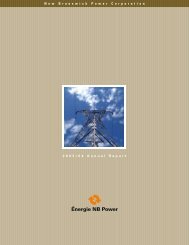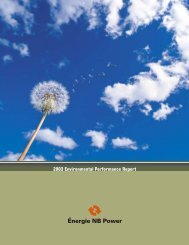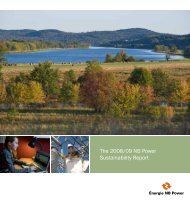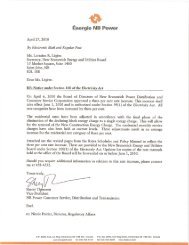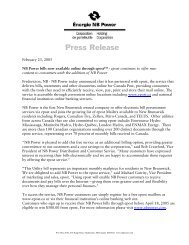Environmental Impact Assessment(EIA) Registration for the ...
Environmental Impact Assessment(EIA) Registration for the ...
Environmental Impact Assessment(EIA) Registration for the ...
You also want an ePaper? Increase the reach of your titles
YUMPU automatically turns print PDFs into web optimized ePapers that Google loves.
REVISED PROJECT DESCRIPTION AND ENVIRONMENTAL IMPACT ASSESSMENT (<strong>EIA</strong>) REGISTRATION<br />
FOR THE NEPISIGUIT FALLS GENERATING STATION MODIFICATION AND REHABILITATION PROJECT<br />
fish species <strong>for</strong> consideration in <strong>the</strong> headpond and upstream portions of <strong>the</strong> Nepisiguit River is<br />
brook trout. Conclusions in relation to brook trout will be assumed to be generalized to o<strong>the</strong>r<br />
fish species. Electrofishing data collected by NSA and PFN (2010) show that <strong>the</strong> fish species<br />
present above <strong>the</strong> dam are predominantly brook trout, dace (species not identified), slimy<br />
sculpin and occasional American eel.<br />
Minns (1997) developed an approach to <strong>the</strong> “no net loss” of productivity <strong>for</strong> fish habitat in<br />
Canada, taking <strong>the</strong> approach that no net loss of productivity is <strong>the</strong> guiding principle <strong>for</strong> Canadian<br />
policy. Minns noted that <strong>the</strong> productivity of a river reach (P, kg/year) is <strong>the</strong> product of unit area<br />
productivity rate (P, kg/ha/year) and <strong>the</strong> area of <strong>the</strong> habitat (A, ha). The unit area productivity<br />
rate can itself be broken down into <strong>the</strong> product of biomass (B, kg/ha) and <strong>the</strong> tissue turnover or<br />
instantaneous growth rate (G, equivalent to <strong>the</strong> P:B ratio, having units of 1/year). Hence, <strong>the</strong><br />
current productive capacity of <strong>the</strong> reach (P) depends upon <strong>the</strong> interplay between <strong>the</strong> area of <strong>the</strong><br />
habitat, <strong>the</strong> biomass, and <strong>the</strong> instantaneous growth rate of fish. Importantly, provided <strong>the</strong><br />
growth rate of fish is unchanged, <strong>the</strong> productive capacity of a river reach can remain unchanged<br />
if <strong>the</strong> biomass of fish increases in proportion to <strong>the</strong> temporary reduction of habitat area (i.e., if<br />
<strong>the</strong> 13% reduction in habitat area is matched by a 13% increase in fish population density).<br />
The brook trout population upstream of <strong>the</strong> falls is independent of <strong>the</strong> population downstream,<br />
since downstream fish cannot ascend <strong>the</strong> falls, and genes associated with <strong>the</strong> sea-run<br />
population of brook trout cannot enter <strong>the</strong> upstream population. In addition, studies (Elliott<br />
1989, Northcote 1981) have shown that salmonid populations living upstream from falls<br />
experience strong selection <strong>for</strong> resistance to downstream migration, since such migration is<br />
irreversible and would deplete <strong>the</strong> population. There<strong>for</strong>e, while some fish will from time to time<br />
be entrained through <strong>the</strong> penstocks or spilled over <strong>the</strong> dam, this will be a relatively rare event.<br />
The normal response to stress (e.g., high flows or crowding) <strong>for</strong> fish living in <strong>the</strong> headpond will<br />
be upstream migration ra<strong>the</strong>r than downstream migration. Fish that overwinter in <strong>the</strong> headpond<br />
are reported (R. Baker, pers. comm. 2010, 2011) to make precisely this kind of migration in<br />
May-June, when <strong>the</strong> headpond will be dewatered. There<strong>for</strong>e, draw down of <strong>the</strong> headpond will<br />
coincide with <strong>the</strong> natural migratory behavior of <strong>the</strong> fish, such that any stress that might be<br />
imposed on <strong>the</strong> fish due to draw down and/or increased crowding will be relieved by <strong>the</strong>ir<br />
natural migratory behavior.<br />
Productivity of salmonid fish populations in spawning areas (i.e., in low-order streams, but not in<br />
<strong>the</strong> headpond) is normally dominated by <strong>the</strong> production of juveniles, particularly 0+ and 1+<br />
cohorts (Elliott 1984, 1987, 1989). In <strong>the</strong>se areas of good and highly productive habitat, high<br />
rates of egg deposition result in high levels of juvenile emergence, and subsequent survival and<br />
production of fish may be density-dependent (Elliott 1984, 1987, 1989) if <strong>the</strong> population size<br />
approaches <strong>the</strong> carrying capacity of <strong>the</strong> habitat. External events, such as catastrophic spates or<br />
drought often regulate <strong>the</strong> overall population density, although recovery from <strong>the</strong>se events can<br />
be rapid due to <strong>the</strong> high capacity of salmonids to deposit eggs. Data collected by NSA<br />
(NSA 2010, NSA and PFN 2010, R. Baker pers. comm.) show that brook trout densities in <strong>the</strong><br />
main stem of <strong>the</strong> Nepisiguit River upstream of <strong>the</strong> headpond ranged from 500 to 1,000/ha in<br />
2009, and were around 1,300/ha in 2010, with fish ranging from 5 to 23 cm in length. In 2010,<br />
June 15, 2011 Page 59




